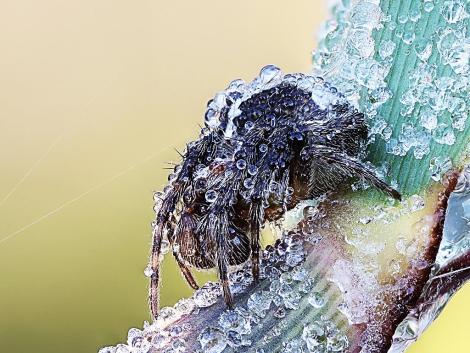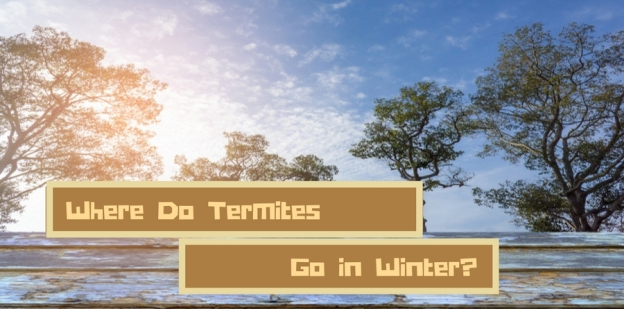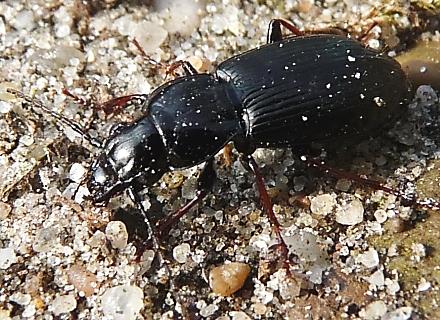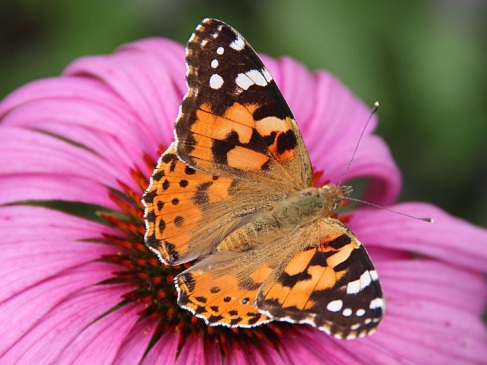Insects and Spiders Escape Freezing to Death in Winter, Showing How God’s Providential Bioengineering Equips Bugs for Phenological Success
Dr. James J. S. Johnson

Fishing Spider, on (and under) Ice! [McGill University Arthropod Ecology]
While the earth remaineth, seedtime and harvest, and cold and heat, and summer and winter, and day and night shall not cease. (Genesis 8:22)
During torrid July days you might miss winter weather.(1) However, in higher latitudes (such as those in the cold north of Scandinavia, Iceland, Greenland, Siberia, Alaska, etc.), it’s winter weather that needs mitigation. Brrrrr!
Winter-wonderland bugs (i.e., arctic insects and arachnids) need to be equipped with bioengineering adaptabilities, programmed to select coping responses to physiological-sensor-tracked climate condition changes, because they are cold-blooded, so failure to self-adjust to freezing weather means freezing to death!
So how can insects and arachnids withstand frigid forces of frost and freezing?(2)
With careful bioengineering (and environmental tracking software programming), God has providentially prepared multi-legged creepy critters to use different solutions to the same problem.

Frozen Spider [photo credit: Stanislav Snall ]
Why is winter weather such a challenge, to “bugs” (cold-blooded insects and arachnids) whom God has directed to “be fruitful, multiply, and fill the earth”?
Many climatic features of arctic regions limit the ways in which insects [and arachnids] can live. … All [arctic] species experience severe cold in winter … [and] the presence of permafrost everywhere except in deep lakes and in the substrates of some running waters means that unfrozen habitats are not available to most species, and even individuals buried in substrates experience prolonged temperatures of about -20OC in the high Arctic [cite omitted]. Nevertheless, constant darkness in winter without solar heating or marked diel [i.e., 24-hour] cycles means that temperatures, though severe, are somewhat less variable than in temperate regions.
The winter is very long. Species sealed in ice will not be exposed to the air again for many months, and might require the ability to respire anaerobically as temperatures rise before the ice melts.
Summer is short and cool … [so the] mean frost-free season is very short, only 9 days [in the high Arctic], so that cold-hardiness is required even during the warmest summer period. This short season starts slowly as habitats warm up. Wet habitats and low-lying areas where snow has accumulated through drifting in winter warm up especially slowly.
Many potential resources of food are in short supply in arctic regions [cite omitted], which makes insect [and arachnid] development during the short summer season even more difficult.
Constraints on development imposed by limited resources for food, heat, [sunlight] and time are offset by the fact that the temperature of habitats, especially at the ground surface and in shallow waters where most insects [and arachnids] live, can be greatly increased by solar heat. Therefore, the extent of summer cloud cover is very important. Cloud cover varies especially according to proximity to the sea, both on a local scale and according to the size of regional land masses, because the sea contributes moisture to the air when it is ice-free in summer.
Arctic regions are very dry, and often have been referred to as polar desert. Only a few centimetres of rain fall each year in the high Arctic … [so such] dryness may hinder insect development, and interacts with the effects of temperature.(3)
Five problem-solving strategies, for how bugs (i.e., various insects and arachnids, including spiders) to avoid being frozen to death, follow.
Options # 1 & # 2:

[ chart credit: Xerces Society for Invertebrate Conservation ]
Live Where It Never Freezes, or Migrate to Avoid Freezing
The easiest survive-the-cold strategy is to live, as jungle bugs do, where it never gets cold enough to freeze. Another avoidance strategy is seasonal migration, illustrated by Monarch Butterflies, which migrate southward for overwintering, then return when warmer spring weather returns.(4)
It should be noticed, however, that Monarch butterflies use a multi-generational approach to their complete migratory cycle — one generation flies south (e.g., form Canada or America to Mexico), yet it takes more than one generation to complete the reverse migration back north, before the autumn winds are used for flying south again:
Butterflies look so delicate as they flitter from flower to flower. And yet, they are capable of migrating incredibly long distances. The monarch, for example, migrates between Canada and Mexico, covering distances of up to 4,800 kilometers, riding a combination of columns of rising air, called thermals, and air currents to travel around 80 to 160 kilometers per day. No single monarch makes this entire journey, though. The round trip is done by a succession of as many as five generations of butterflies.(5)
However, there is a resilient butterfly, whom God has painted with similar wing colors (yet a different pattern of those orange, black, and white colors), the Painted Lady. This hardy-yet-dainty butterfly truly exhibits marathon stamina.
Painted ladies are found throughout much of the world, except for South America and Australia. They’ve been seen as far north as Svalbard, Norway, and nearly as far south as Antarctica.
The butterflies are known to migrate, particularly between Europe and Africa, but their route has been largely unknown. Scientists had tracked the butterflies to northern Africa (the region known as the Maghreb), but there have been hints that they may fly across the Sahara. Two new studies back up this claim.(5)
[ PAINTED LADY (Vanessa cardui) on Purple Coneflower / Wikipedia image ]
Migrating from Norway, south to Africa? Now that is marathon migration!
Option # 3:
 Subterranean Termites [photo credit: Pestkilled.com ]
Subterranean Termites [photo credit: Pestkilled.com ]
Some non-migratory social insects, including ants and termites, survive winter by hunkering down (called “diapause”, similar to hibernation) in underground colonies located below the frost line. There they stay warm, feeding on food they stored earlier.(6) Diapause is also useful for slowing down metabolic processes till the time of year when full-blown metabolism is optimized due to food availability in a given habitat. (No need to be voraciously hungry when the local food supplies are slim pickin’s!)
In fact, building a winter cocoon for temperature insulation, is functionally equivalent to modifying a micro-habitat, to avoid outside freezing temperatures, as is done by some chironomid midges (a/k/a “lake flies”).(3) Winter cocoons shelter the indwelling larvae from injury from icy weather conditions.

[ image credit: Griffin Pest Solutions ]
Some alpine beetles are known to use diapause (a hibernation-like semi-dormant state of slowed-down metabolism), to slow down the “normal” energy-demanding activities of growth and development, during winter. Ordinary oxidative metabolism is suppressed, being temporarily replaced by anaerobic metabolism processes, facilitating cryoprotectant (i.e., protection-against-cold) systems within the beetles, regulating their development to avoid vulnerability to continued super-cold conditions.(3)
Of course, there are two phenological scenarios for synching life-cycle developments with the 4 seasons: (1) bugs that live at least a full year before reproducing the next generation; and (2) bugs that live less than a full year before reproducing.(3) The former category require bioengineering design to enable them to survive all of their habitat’s seasons, but the latter category can be phenologically fitted to the 4 seasons by life stages, so that the life stages are synched to survive the weather of that stage’s time of year. This option is illustrated by the Monarch Butterfly’s multi-generation migration.
Options # 4 & # 5:

Carabid Ground Beetle / photo credit: Mark Eising
Super-cooling “Anti-freeze” and/or Freeze Tolerance
Another amazing option for many insects and spiders, for surviving freezing weather, is safeguarding hemolymph [i.e., bug “blood”] with “antifreeze” biochemicals. (Obviously, this requires bug sensors detecting temperatures.)
God designed and built some bugs with physiologies that lower the hemolymph’s freezing point, using thermal hysteresis proteins (i.e., “antifreeze” proteins), in conjunction with sugar polymers (such as xylomannan) and/or glycerol.(7),(8)
Insects survive low temperatures either by keeping their body fluids liquid below their ordinary freezing point (freeze avoidance), or by surviving the formation of ice in their tissues (freeze tolerance)….
For species inhabiting in temperate and colder climates, the ability to supercool is undoubtedly the most important component of the overwintering strategy. At temperatures below 0OC, most insect species remain unfrozen because they supercool. Cold-hardiness can be
measured by indices such as supercooling points (SCP), the temperature at which spontaneous freezing occurs [cite omitted].
Freeze-avoiding insects keep their body fluids liquid by removing ice nucleators that initiate ice formation, synthesizing antifreeze proteins to reduce the nucleation potential of seed crystals, and accumulating sugars and polyols, such as glycerol or trehalose, which also lower the crystallization temperature (defined as its super-cooling point) and stabilize membranes at low temperatures [cite omitted].(9)
Most bugs that survive freezing temperatures are actually using biochemical “antifreeze” to supercool their hemolymph, but some bugs actually tolerate some amount of freezing.(7),(8),(9),(10)
Arthropods that live in sub-zero temperatures for at least part of the year survive by one of two physiological and biochemical responses.
At least for insects, one way is tolerance of ice crystal formation in their bodies (freeze tolerance), and the other is avoidance of ice crystal formation (freeze avoidance).
Ice crystal formation is avoided by super-cooling, which depresses the freezing point. … [facilitated by] accumulation of polyol compounds in the hemolymph (thus increasing the osmotic pressure), dehydration (also increasing osmotic pressure), synthesis of thermal-hysteresis protein, or evacuation or masking of ice-nucleation factors in the gut.(8)
Freeze-tolerant insects, such as arctic beetles, appear to employ physiologies that manipulate intracellular ice-nucleating agents (and apply protein-stabilizing cryoprotectant substances), to limit hemolymph ice crystal formation to extracellular compartments, preventing intracellular crystallization.(7),(10)
Now how would beetles accidently “evolve” these magnificent adaptabilities, phenologically indexed to Earth’s annual temperature and photoperiodicity rhythms? With universal entropy fighting against their chances of survival, as well as every detail of their biochemistry, they need much more than “luck”!(11)
Hit-or-miss mutations, accidently “emerging” in insect (or spider) genomes, cannot biochemically code bio-informational “software” and physiological “hardware” of bug bodies, to so successfully fill super-cold habitats! These bugs need life-saving temperature detectors to trigger built-in selective logic, that switches (on or off) physiological responses, that are focally targeted to avoid allowing the bugs to freeze to death!
So, what does all of this phenological winter-survival evidence prove? Divine design! Due to the cold logic of biochemistry, these super-cool critters can’t be lucky products of evolutionary “genes-in-magic”. Rather, they showcase God’s providential “programmed-to-fill” bioengineering!
REFERENCES
(1)Contentment, as seasons and weather change, can be a challenge (Philippians 4:11). After the Flood, God promised that Earth would experience predictable seasonal weather cycles, including recurring cold weather (Genesis 8:22).
(2)Some say that winter frost or icy freezes kill off the bugs—yet the bugs always return in spring, so obviously they are surviving winter somehow!
(3)H. V. Danks, Olga Kukal, & R. A. Ring, “Insect Cold-Hardiness: Insights from the Arctic”, Arctic, 47(4):391-404 (December 1994), quotation from page 392.
(4)Moody Science Institute, “Animal Kingdom: Great Are Thy Works” (The Wonders of Creation DVD series, vol. 2, 1993).
(5) Sarah Zielinski, “Painted Lady Butterflies’ Migration May Take Them Across the Sahara”, Science News, October 12th, 2016 ( https://www.sciencenews.org/blog/wild-things/painted-lady-butterflies%E2%80%99-migration-may-take-them-across-sahara ). See also Gerard Talavera & Roger Vila, “Discovery of Mass Migration and Breeding of the Painted Lady Butterfly Vanessa cardui in the Sub-sahara: the Europe—Africa Migration Revisited”, Biological Journal of the Linnean Society, 20(2):274-285 (February 2017), posted at https://doi.org/10.1111/bij.12873 (“The distribution range of V. cardui is much wider than that of the monarch. It is a virtually cosmopolitan species that can be found everywhere except most of South America and Australia. Thus, Vanessa cardui has one of the largest distributional ranges among terrestrial animals that undertake large-scale migratory movements [cite omitted]. Occasional records exist for extremely cold localities, as for example, near the Arctic polar circle in Svalbard, Norway [cited omitted] and close to the Antarctic … [cite omitted].”).
(6)Proverbs 30:25 (“ants … prepare their food in the summer”). See also Brian J. Cabrera & Shripat T. Kamble, “Effects of Decreasing Thermophotoperiod on the Eastern Subterranean Termite (Isoptera: Rhinotermitidae)”, Environmental Entomology, 30(2):166-171 (2001); https://doi.org/10.1603/0046-225X-30.2.166 (“[S]uccessfully overwintering R. flavipes [termite] colonies retreat to soil depths where freezing temperatures are not encountered.”)
(7)Lauritz Sømme, Invertebrates in Hot and Cold Arid Environments (Springer, 1995), 194-213. Regarding xylomannan’s role, in Alaska’s flat bark beetle, see Ned Rozell “Alaska Beetle Survive ‘Unearthly’ Temperatures”, Geophysical Institute, article # 2104 (University of Alaska Fairbanks, March 1, 2012).
(8)Jonathan Murphy, Tatiana Rossolimo, & Sina Ada, “Cold-hardiness in the Wolf Spider Pardosa groenlandica (Thorell) with Respect to Thermal Limits and Dehydration”, Journal of Arachnology, 36:213-215 (2008), omitting inline cites.
(9)Angela Ploomi, Irja Kivimägi, Eha Kruus, Ivar Sibul, Katrin Jõgar, Külli Hiiesaar, & Luule Metspalu, “Seasonal Cold Adaptation Dynamics of Some Carabid Beetle Species: Carabus granulatus, Pterostichus oblongopunctatus, and Platynus assimilis”, Forestry Studies [Metsanduslikud Uurimused], 57: 90-96 (2012), quotation from page 90. [The lead co-author, Angela Ploomi, of Estonian University of Life Sciences (in Tartu), is reachable at angela.ploomi@emu.ee ]
(10)Karl Erik Zachariassen & Harold T. Hammel, Nucleating Agents in the Haemolymph of Insects Tolerant to Freezing, Nature, 262:285-287 (July 22, 1976).
(11)James J. S. Johnson, “Infinite Time Won’t Rescue Evolution”, Acts & Facts, 47(6):21 (June 2018), posted at http://www.icr.org/article/infinite-time-wont-rescue-evolution .
><> JJSJ profjjsj@aol.com
[No Scandinavian or other Arctic-region insects or bugs were harmed during this study.]


Pretty cool!
LikeLiked by 1 person